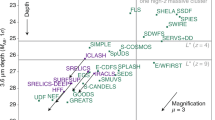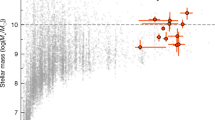Abstract
WE have completed a series of observations at Jodrell Bank on the radio structures of a complete sample of QSO candidates identified from the Parkes ±4° equatorial survey. Four sources are of particular interest in that they have properties which lead us to suggest that they may be QSOs of unusually high redshift.
This is a preview of subscription content, access via your institution
Access options
Subscribe to this journal
Receive 51 print issues and online access
$199.00 per year
only $3.90 per issue
Buy this article
- Purchase on Springer Link
- Instant access to full article PDF
Prices may be subject to local taxes which are calculated during checkout
Similar content being viewed by others
References
Stannard, D., Nature, 246, 295 (1973).
Bahcall, J. N., and Sargent, W. L. W., Astrophys. J. Lett., 148, L65 (1967).
Miley, G. K., Mon. Not. R. astr. Soc., 152, 477 (1971).
Wardle, J. F. C., and Miley, G. K., Astr. Astrophys., 30, 305 (1974).
Setti, G., and Woltjer, L., Astrophys. J. Lett., 181, L61 (1973).
Wall, J. V., Shimmins, A. J., and Merkelijn, J. K., Aust. J. Phys., astrophys. Suppl., 19, (1971).
Baldwin, J. A., et al., Astrophys. J., 185, 739 (1973).
Strittmatter, P. A., Carswell, R. F., Gilbert, G., and Burbidge, E. M., Astrophys. J., 190, 509 (1974).
Author information
Authors and Affiliations
Rights and permissions
About this article
Cite this article
BROWNE, I., BENTLEY, M., HAVES, P. et al. QSOs of high red shift?. Nature 252, 209–210 (1974). https://doi.org/10.1038/252209a0
Received:
Issue Date:
DOI: https://doi.org/10.1038/252209a0
This article is cited by
-
Extinction of taxa and Van Valen's law
Nature (1975)
Comments
By submitting a comment you agree to abide by our Terms and Community Guidelines. If you find something abusive or that does not comply with our terms or guidelines please flag it as inappropriate.



